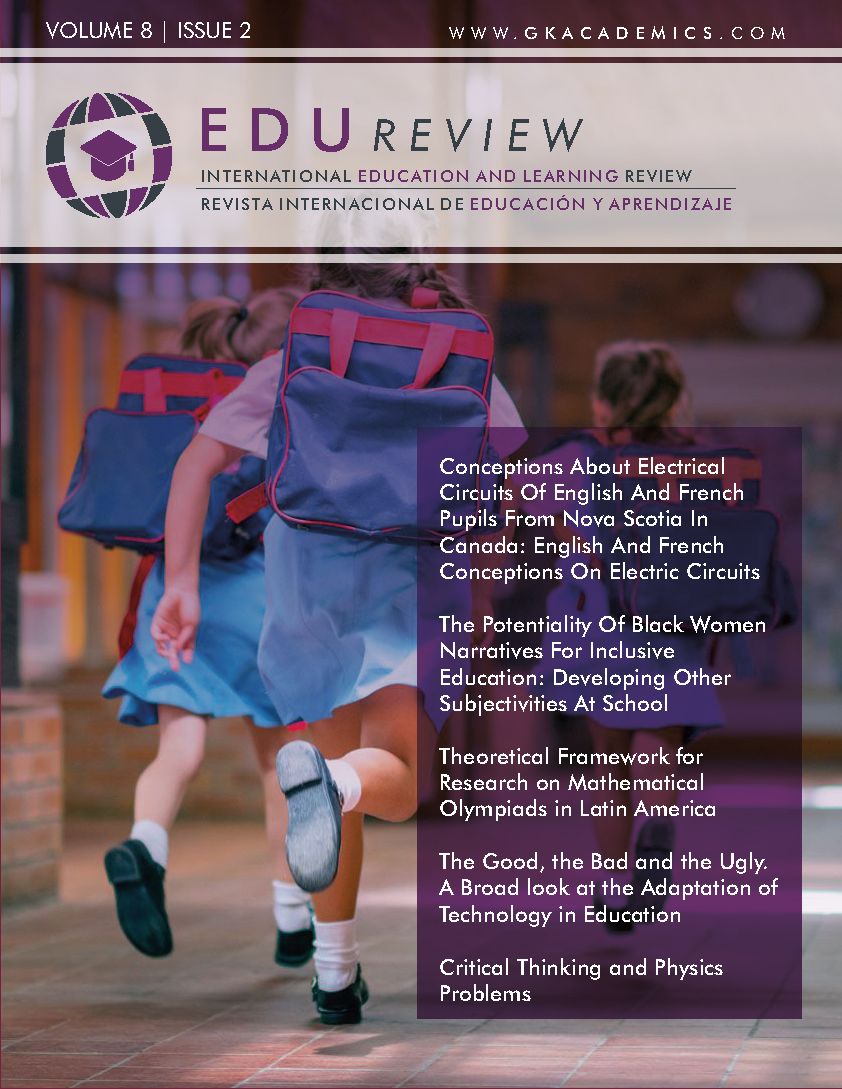Conceptions About Electrical Circuits Of English And French Pupils From Nova Scotia In Canada: English And French Conceptions On Electric Circuits
DOI:
https://doi.org/10.37467/gka-revedu.v8.2639Palabras clave:
Conceptions, Electrical Circuits, Pupils, English and French, Universality, Elementary schoolResumen
This research study was designed to identify the conceptual understandings of 89 students from the region of Clare in French-language public schools and 105 students from the Argyle region in French immersion public schools in Canada on the operation of simple electrical circuits. To this end, they completed a pencil-and-paper questionnaire of sixty minutes in duration. The analyses of the data show clearly the preponderance of erroneous understandings by students related to the concepts of current and voltage among other related concepts identified in the international review of the literature. Thus, despite the cultural and language differences, their conceptual understandings related to the simple electrical circuit are similar. A conclusion and didactical impact are included.
Citas
Allen, M. (2010). Misconceptions in Primary Science. New York: Open University.
Canal, J.-L. (1986). The speed to the middle course. Aster, 2, 133-166. DOI: https://doi.org/10.4267/2042/9197
Carlton, A. (2000). Teaching about heat and temperature. Physics Education, 35(2), 101-105. DOI: https://doi.org/10.1088/0031-9120/35/2/304
Chu, H. E., Treagust, S. & Zadnik, S. Yeo. (2012). Evaluation of Students’ Understanding of Thermal Concepts in Everyday Contexts. International Journal of Science Education, 34 (10), 1509-1534. DOI: https://doi.org/10.1080/09500693.2012.657714
Dédès, C. & Ravanis, K. (2007). Reconstruction of the spontaneous representations of the pupils: The formation of the shades by the extended sources. Skholè, hors série, 1, 31 39. DOI: https://doi.org/10.1007/s11165-007-9074-5
Engel Clough, E. & Driver, R. (1985). Secondary student’s conceptions of the conduction of heat; bringing together scientific and personal views. Physics Education, 29, 176 182. DOI: https://doi.org/10.1088/0031-9120/20/4/309
Erickson, G. (1980). Children’s viewpoints of heat: A second look. Science Education, 64, 323-336. DOI: https://doi.org/10.1002/sce.3730640307
Fredette, N., & Lochhead. (1980). Student conceptions of simple circuits. Physics Teacher, March, 194-198. DOI: https://doi.org/10.1119/1.2340470
Fox, R. (1971). The Caloric Theory of gases from Lavoisier to Regnault, Oxford, Clarendon Press.
Invernizzi, S., Marioni, C. and Sabadini, P. (1989). Mouvement and speed to the elementary course. Aster, 8, 211-223. DOI: https://doi.org/10.4267/2042/9161
Jabot, M. & Henry, D. (2007). Mental Models of Elementary and Middle School Students in Analyzing simple Battery and Bulb Circuits. School Science and Mathematics, 107, 371-381. DOI: https://doi.org/10.1111/j.1949-8594.2007.tb17760.x
McDermott, Lilia C. (2004). Conceptions des élèves et résolution de problèmes en mécanique, In Des connaissances naïves au savoir scientifique, responsable A. Tiberghien. UMR GRIC, CNRS, Université Lumière, Lion, Chapitre C1, 11 pages.
Métioui, A. (2019). Quebec Elementary Pre-service Teachers’ Conceptual Representations about Heat and Temperature. International Journal of Educational and Pedagogical Sciences, 13(5), pp. 712-717.
Métioui, A. & Trudel, L. (2017). Misconceptions and history of science in science-student education: force-gravity and motion. International Journal of Technical Research and Applications, 5 (1), 88-94.
Métioui, A. & Baulu MacWillie, M. (2013). Children's Beliefs about the Concepts of Distance, Time and Speed. International Journal of Education, Learning and Development, 1, 24-38.
Métioui, A. & Baulu MacWillie, M. (2015). Children’s beliefs about the transformations of energy in three countries (Canada, France and Morocco). Universal Journal of Educational research, 3, 75 84. DOI: https://doi.org/10.13189/ujer.2015.030202
Métioui, A. & Baulu MacWillie, M. (2015). Pupil’s Beliefs about the Transformations of Energy in Three Countries (Canada, France and Morocco). Universal Journal of Educational Research, 3, 75-84. DOI: 10.13189/ ujer.2015.030202 DOI: https://doi.org/10.13189/ujer.2015.030202
Métioui, A. & Baulu-Mac Willie, M., Trudel, L. (2016). Conceptions of pupils of the primary on the topic of an electric circuit in three countries (Canada, France and Morocco). European Journal of Science and Mathematics Education, 4 (4), 469‐476. DOI: https://doi.org/10.30935/scimath/9486
Métioui, A. (2019). Quebec Elementary Pre-service Teachers’ Conceptual Representations about Heat and Temperature. International Journal of Educational and Pedagogical Sciences, 13(5), 712-717.
Métioui, A., & Trudel, L. (2012). The model of the rectilinear propagation of light and the study of the variation of the size of a shadow. US-China Education Review, 2(9): 173-186.
Osborne, R. J. (1982). Investigating Children’s Ideas About Electric Current Using an Interview-About-Instances Procedure. Hamilton, New Zealand: SURU, University of Waikito.
OECD PISA (2015). À la hauteur : Résultats canadiens de l’étude PISA de l’OCDE. Le rendement des jeunes du Canada en sciences, en lecture et en mathématiques. Premiers résultats de 2015 pour les jeunes du Canada âgés de 15 ans. Éditions OCDE.
Ravanis, K., Zacharos, K. & Vellopoulou, A. (2010). The formation of shadows: The case of the position of a light source in relevance to the shadow. Acta Didactica Napocensia, 3(3), 1-6.
Selley, N. J. (1996). Children’s ideas on light and vision. International Journal of Science Education, 18(6), 713-723. DOI: https://doi.org/10.1080/0950069960180605
Sözbilir, M. (2003). A Review of a Selected Literature on Students’ Misconceptions of Heat and Temperature. Boğaziçi University Journal of Education, 20(1), 25-41.
Tao, Y., Olivier, M. & Venville, G (2012). Chinese and Australian children’s conceptual understanding of science: A multiple comparative case study. International Journal of Science Education, 34, 879-901. DOI: https://doi.org/10.1080/09500693.2011.578679
Tiberghien, A., Delacote, G., Ghiglione, R. & Matalon, B. (1980). Conception de la lumière chez l’enfant de 10-12 ans. Revue française de pédagogie, 50, 24-41. DOI: https://doi.org/10.3406/rfp.1980.1711
Tiberghien, A. (1983). Critical review of research concerning the meaning of electric circuits for students aged 8 to 20 years. In Reacher on Physics Education, Proceedings of the first International Workshop, La Londe les Maures, France, Editions du Centre National de la Recherche Scientifique, Paris, 109-123.
Tiberghien, A. (1985). The development of ideas with teaching, in R. Driver, E. Guesne and A. Tiberghien (dirs.), Children’s Ideas in Science, Milton Keynes, England: Open University Press, pp. 67-84.
Watts, D. M. (1983). A study of school children’s alternative frameworks of the concept about force. European Journal of Science Education, 5 (2), 217-230. DOI: https://doi.org/10.1080/0140528830050209
Webb, P. (1992). Primary science teachers’ understandings of electric current. International Journal of Science Education, 14(4), 423-429. DOI: https://doi.org/10.1080/0950069920140405
Descargas
Publicado
Cómo citar
Número
Sección
Licencia
Aquellos autores/as que publiquen en esta revista, aceptan los términos siguientes:
- Los autores/as conservarán los derechos morales sobre la obra y cederán a la revista los derechos comerciales.











